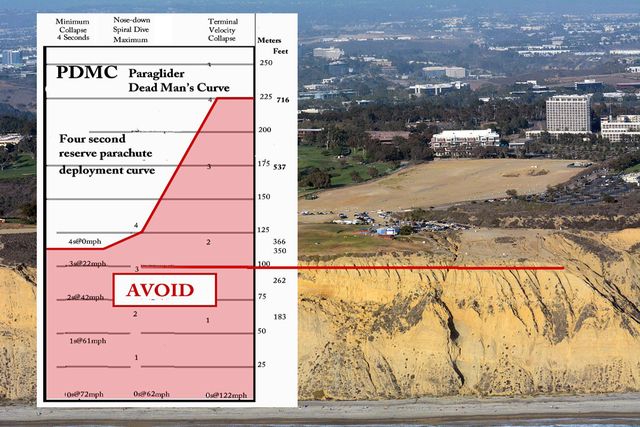Would paragliding's fatality and injury rate give USPA second or third or fourth pause?
https://skydiveuspa.wordpress.com/2012/ ... at-a-time/

Would paragliding's fatality and injury rate give USPA second or third or fourth pause?


JoeF wrote:Would paragliding's fatality and injury rate give USPA second or third or fourth pause?
https://skydiveuspa.wordpress.com/2012/ ... at-a-time/

Skydivers don't try to soar in turbulent air
In 2014, USPA recorded 24 fatal skydiving accidents in the U.S. out of roughly 3.2 million jumps.
2014 had 0.65 fatalities per thousand USPA members
in the 1960s, there was an average of 3.65 fatalities per thousand USPA members.



Plaikind, Paragliding Forum, September, 2011
Much has been written in this forum about Rick Masters and his Mythology of the Airframe website.
https://web.archive.org/web/20110926073 ... lones.com/
I quickly looked over much of what has been written – there is too much to read it all – and the responses seem pretty consistent. Generally the opinion is that he is a bit of a crackpot on a rant with a poor understanding of the current state of the sport. However, what I haven't seen (or missed) is any comment on his statistics. Is it accurate that there have been 850 paraglider fatalities in the last 8 years? Given the relatively small number of pilots and assuming the number of injuries is likely a multiple of the number of fatalities that seems like a pretty concerning statistic if true.
I feel I am learning the risks and I note that many of the accidents I read about are pilot error. For instance I have noted a surprising number of fatalities because a pilot neglected to strap in! Those risks don't concern me because I have control over that. I also see accidents where you have mid-air collisions. Again, while I may not have full control over that I can understand that risk and take care to avoid it. The accidents I am struggling with are the ones where an experienced pilot, not pushing the envelope in a competition, flying in relatively benign conditions suffers a collapse, spiral or other mishap that leads to injury or death. That strikes me as uncontrollable risk. ...I am taking steps to minimize the risk of PG. I am focused on getting good training, I don't fly if I am at all concerned about the conditions, I purchased an appropriate wing and I will be going to an SIV Clinic in a couple of weeks. Still it seems like paragliding may have more uncontrollable risk than I am used to. I am not trying to talk myself out of the sport but I have a six year old at home so I do need to think about this. Of course, one could argue that I should stop all my risky activities and perhaps that is the case. However, when people ask me if I am not afraid of dying I usually reply that it concerns me but I am more afraid of not living.
Ikarus, Paragliding Forum
What you have identified is the uninformed, and frankly malicious scaremongering of a certain sector of the flying community. Their motives baffle me, I have to say. We have learned that there is little point in trying to engage with them.
Sure, there are some things that you simply cannot plan for, but the more you fly, the more you come to understand that these are few and far between (like the famous "down draughts"). While the witnesses to a PG accident may say "he just fell out of the sky," most experienced PG pilots fully understand that there's a lot more to it.
Rick's core issue is that a PG has no frame, and if you get a collapse lower than the height required for recovery, PG can be fatal. What he won't acknowledge is that all aircraft have this tendency – if you stall a flex wing within the recovery height, you will pound in. Similarly, he is unlikely to acknowledge that, unlike HG, PG has considerably more control over many of these issues. For example:
- PG is one of the only aircraft that is auto stable - if you let the controls go, a PG will fly straight and level in still air.
- a collapse on a PG is actually a safety feature, as it means that the angle of attack has gone negative relative to the cord line of the aerofoil. This stops the glider from surging uncontrollably below the horizon, like topless HGs were prone to do in the early days.
- in competent hands, most PGs (and all certified PGs) will be able to maintain a safe course at a moderate descent rate following a collapse without dropping into an auto-rotating deep spiral, with correct pilot input. An SIV course will teach you this.
So, from a learning perspective, provided you fly with equipment appropriate to your level under instruction at sites and in weather conditions which are also appropriate, the baseline risk for PG is lower than you might expect. I'm not saying it's safe, but the concerns about not being able to control risk is over stated.
red frogs, Paragliding Forum
Rick is clearly a crackpot, and a list out of context of participation rates has nothing to say as to safety. ...It's the relative to participation numbers which help people understand how inherently dangerous something is.
In Rick's case, there is an assertion that not having an airframe is crazy dangerous, backed up with an internet search based list of fatalities. The premise being that we should all fly a hangglider instead. This is not research, ...looking for hangy fatalities turns up a similar if not larger list, and i'm going out on a completely subjective limb to say hangy participation rates are 1/10th PG rates, so an actual proper study could indeed surmise that having an airframe in a weightshift glider is crazy dangerous.




Users browsing this forum: No registered users and 23 guests